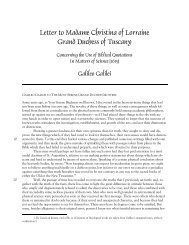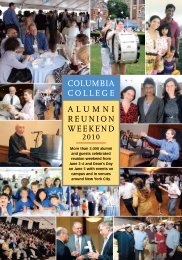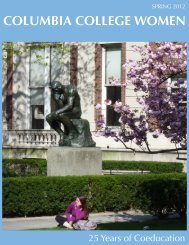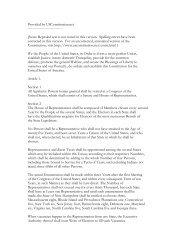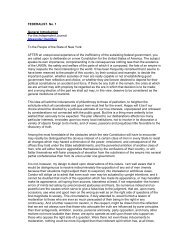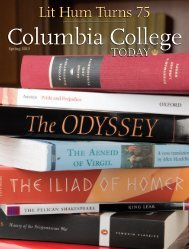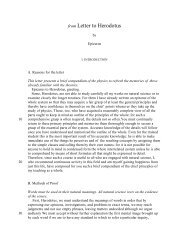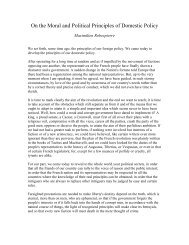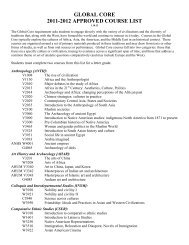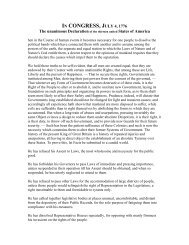Japan Storm - Columbia College - Columbia University
Japan Storm - Columbia College - Columbia University
Japan Storm - Columbia College - Columbia University
Create successful ePaper yourself
Turn your PDF publications into a flip-book with our unique Google optimized e-Paper software.
THE BAUHAUS GROUP: SIX MASTERS OF MODERNISM COLUMBIA COLLEGE TODAY<br />
his priorities. Sharp observation of everyday experience was fundamental.<br />
A keen appreciation for the processes perpetually occurring<br />
in the kitchen, the human body, and the wooded parks<br />
where he and Klee and Albers took their daily walks, governed<br />
his life. What was essential was to stop and look. In his pervading<br />
appreciation of existence and his overwhelming desire both to<br />
celebrate and to add to the world’s store of beauty, he was possessed<br />
by a determination to make the most of every source of<br />
wonder; he would rest only in order to gain strength for action.<br />
Those same desires ruled the lives of several of his colleagues,<br />
but Kandinsky was distinguished among them<br />
in bringing to the mix “the Russian soul.” He had the<br />
particular intensity that fired Pushkin and Tolstoy, that<br />
permeates the chants of the steppes and the icons of the Russian<br />
Orthodox Church, and that has characterized an entire people<br />
through all the transformations of their nation. Will Grohmann,<br />
who observed Kandinsky firsthand at the Bauhaus, writes, “His<br />
uncompromising attitude to life and art, his faith in the unconquerability<br />
of the human spirit, came with him from Russia.” Although<br />
Kandinsky spent most of his life in Germany and Paris,<br />
he not only retained his fervent belief in Orthodox Christianity,<br />
remained immersed in Slavic literature and music, and continued<br />
to speak his native language with his wife; he also guarded<br />
his secrets, and relished a sense of inexplicable mysteries.<br />
Of the Russian types, he was a nobleman out of Turgenev. He<br />
looked every bit the aristocrat, and struck people “as more like<br />
a diplomat or a widely traveled scholar than as an artist.” While<br />
Johannes Itten wore his outlandish costumes and the Bauhaus<br />
students flaunted their bohemianism, Kandinsky dressed with<br />
meticulous elegance. This was true not just in society but also<br />
when he painted. Unleashing his furies as he brazenly applied<br />
vivid pigments to canvas, he wore, at his most casual, a bow tie<br />
and jacket. “I could paint in a dinner jacket,” he once quipped.<br />
But Kandinsky was marked by correctness and reserve rather<br />
than dandyism. In his appearance and demeanor, he had no<br />
wish to attract attention; he “spoke quietly and attentively, and<br />
was never wounding. He behaved impeccably even in painful<br />
situations.” He had genuine style; he was not a showman.<br />
His propriety teetered at the edge of aloofness. For his students<br />
and colleagues, there was always the sense that Kandinsky,<br />
however amiable and cheerful he might appear, had some<br />
very private issues he was deliberately keeping from view. He<br />
was older than everyone else by at least a decade, but it wasn’t<br />
just age that kept him apart. What was that veneer meant to<br />
guard? Grohmann thinks it was masking an overriding instability.<br />
“The more Kandinsky became aware of his psychic<br />
constitution, the more he developed a capacity to control himself<br />
. . . to save face.” Kandinsky was so eager to conceal the<br />
vagaries of his mind that he preferred “chance acquaintances<br />
to half friendships.” The person at the Bauhaus to whom he<br />
was closest was Klee; this suited him in part because Klee, too,<br />
eschewed intimacy. It was like befriending a flock of birds or<br />
an image of St. Christopher — highly rewarding, but without<br />
threat to the privacy Kandinsky guarded so carefully.<br />
Kandinsky’s face rarely came into focus behind the<br />
cloud of smoke from the cigarettes he puffed all day<br />
long. The screening served him well. By the time he<br />
was at the Bauhaus, he had effectively excised from his<br />
story the woman who had been his truest partner, the brilliant<br />
painter Gabriele Münter; all that one could glean about Münter<br />
from the elusive Kandinsky was that, in her bitterness over his<br />
having left her and, shortly thereafter, taken up with the young<br />
playgirl who was now his wife, she had refused to return a lot<br />
of the art he had left in her care a decade earlier.<br />
But even if Kandinsky would not discuss the details of his<br />
past, students and teachers of every level and a range of styles<br />
admired him immensely. He was the voice of reason in Bauhaus<br />
disputes, where his ability to keep his personal reactions hidden<br />
set him apart, and he was respected for his balanced perspective<br />
on complex issues. While establishing careful perimeters<br />
around his private self, he was open to infinite approaches in<br />
most matters. Anni Albers recalled, with a broad smile, “Kandinsky<br />
often said, ‘There is always an and.’ ” Grohmann refers<br />
to Kandinsky’s wish “to express mystery in terms of mystery.”<br />
There were layers beyond and beneath the layers; that complexity<br />
inspired extraordinary thinking and completely original art.<br />
He was possessed by a determination to make<br />
the most of every source of wonder.<br />
WINTER 2011–12<br />
42<br />
Wassily Kandinsky was born in Moscow, on December<br />
4, 1866 — in the same decade that Tolstoy’s<br />
War and Peace and Dostoevsky’s Crime and<br />
Punishment were published, and Mussorgsky’s<br />
Boris Godunov was first performed. His earliest memories consisted<br />
of shapes and colors of the sort that would eventually<br />
become the substance of his art. When he was three years old,<br />
the family’s coachman would strip spirals of bark from thin<br />
branches, “cutting away both layers of bark from the first spiral,<br />
and from the second only the top layer.” Little Wassily saw the<br />
forms as abstracted horses, with the outer bark a “brownish yellow<br />
. . . which I disliked, and would gladly have seen replaced,”<br />
and the second layer a “juicy green . . . which I loved most particularly<br />
and which, even in a withered state, still had something<br />
magical about it.” The wood of the now-naked branch<br />
was “ivory-white . . . which smelled damp, tempting one to lick<br />
it, but soon withered miserably and dried, so that my pleasure<br />
in this white was spoiled from the outset.” Colors would induce<br />
intense emotions in him for the rest of his life.<br />
Bright hues made him rapturous; black induced fear. At age<br />
three, he also went to Italy with his parents and his Russian governess,<br />
and retained an impression of a frightening black carriage<br />
in which he and his mother crossed a bridge over “dirty yellow”<br />
water in Florence when he was on his way to kindergarten. Even<br />
more terrifying were “steps leading down into black water, on<br />
which floats a frightening, long, black boat with a black box in the<br />
middle. . . . I . . . bawled my head off.”<br />
When Wassily was five, his family moved to Odessa, where he<br />
spent the rest of his childhood. He had not been there long when<br />
he painted a watercolor of a horse. His aunt — his mother’s older<br />
sister, Elizaveta Ivanovna Tikheeva, who lived in the house and<br />
helped him with his art — had asked him to hold off doing the<br />
hooves until she was there to advise him. Initially, the boy was con-




